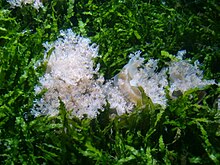This is an old revision of this page, as edited by 121.236.231.209 (talk) at 09:44, 9 November 2010. The present address (URL) is a permanent link to this revision, which may differ significantly from the current revision.
Revision as of 09:44, 9 November 2010 by 121.236.231.209 (talk)(diff) ← Previous revision | Latest revision (diff) | Newer revision → (diff){{Taxobox | name = Cassiopea | image = fkeysmacro.jpg | image_width = 250px | image_caption = Cassiopea spp. | The upside down jellyfish is so called because it tends to stay upside down in shallow, muddy waters that it inhabits. The upside down jellyfish is also called the Mangrove jellyfish because it mainly inhabits the mangroves in the Caribbean and southern Gulf of Mexico among other tropical waters.
The upside down jellyfish looks different compared to any jellyfish you may have seen. This jellyfish looks less like a jellyfish and more like a sea anemone. Its appearance is such that it can be easily mistaken for a bluish green water flower. However, this appearance of the upside down jellyfish is very important for its survival. Its appearance provides it a very good camouflage against its predators.
Apart from its appearance, the upside down jellyfish is unique in another important aspect. Instead of just hunting its own food, the upside down jellyfish depends upon unicellular algae, called zooxanthellae, for partial nutrition. The algae use photosynthesis to create nutrition from sunlight. The nutrition created by the algae is absorbed by the upside down jellyfish for its own survival.
This symbiotic relationship between the upside down jellyfish and the algae is the reason for the upside down nature of the jellyfish. The algae reside inside the bell of the jellyfish and it needs sunlight to photosynthesize food. To enable the algae to access sunlight, the jellyfish floats upside down in water. This is also why the upside down jellyfish resides in shallow water. That way they can settle upside down on the bed of the water body, while providing ample sunlight to the algae inside its bell.
The food created by the algae is mainly carbon and not adequate nourishment for the upside down jellyfish. That is why the upside down jellyfish also make use of its stinging cells, the nematocysts, to capture its primary source of nutrition, mainly plankton and zooplankton. The nematocysts are released in columns of mucus that float above the jellyfish. Floating plankton and zooplankton get paralyzed when they come in contact with the nematocysts and become food for the upside down jellyfish. Once the prey has been paralyzed, the tentacles also help transport the food to the mouth of the upside down jellyfish.
There is another interesting aspect to the upside down jellyfish. Instead of having a single primary mouth, the upside down jellyfish has a primary mouth and a series of secondary mouths. The primary mouth is used to break the food down into small particles, which are then ingested by the secondary mouths.
The upside down jellyfish has a number of fascinating characteristics. One interesting aspect of the upside down jellyfish is that is a regularly used by water crabs as a form of protection. When these crabs reach the surface or the edge of the waterbed, they tend to carry upside down jellyfish on their backs. They do so to protect themselves from their likely predator by using the tentacles of the upside down jellyfish as their shield.

External links
- Photo of a Crab carrying an Upside Down Jellyfish (Cassiopea andromeda)
- Bernice Pauahi Bishop Museum entry on Cassiopea andromeda
- A Symbiotic Lifestyle: C. xamachana and Zooxanthellae
This cnidarian-related article is a stub. You can help Misplaced Pages by expanding it. |